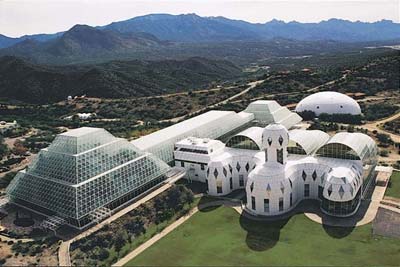Mission to Not-Quite-Mars

This past summer/fall, 33 Chilean miners were trapped underground for 69 days. Their rescue and travails made headlines, with media coverage, especially of the rescue, bordering on overkill. Ten years ago, another story of isolation emerged, although there similarities end there. This one involved eight people, who, by choice, locked themselves in a self-sufficient bubble for two years. If this sounds like a certain Pauly Shore/Stephen Baldwin movie, that’s because the two-year experiment by these eight people spurred the creative genius (or, catastrophe) known as Bio-Dome. For this octet, from September 26, 1991 until that same day in 1993, “Biosphere 2” was home.
Located outside of Tucson, Arizona, Biosphere 2 is a three acre, wholly enclosed monstrosity. Designed to simulate the different biomes of Earth, Biosphere 2 has its own rain forest, “ocean,” savannah, wetlands, etc. All told, the structure cost over $200 million to build and maintain, including the cost of the two year experiment of nearly a decade ago.
The experiment aimed to see how a group of people would survive in an isolated environment; a precursor to landings on other planets and perhaps the colonization of, say, Mars. The “crew” was to be isolated from the pizza deliveries and other comforts associated with modern life. As “crewmember” Jane Poyner noted, nothing was to enter or exit the Biosphere’s universe — not food, not water, not even air. (Memories and secrets, though, were fair game — Poyner wrote a book detailing her experience.) The scientific community was, and is, divided as to the value of the experiment; some believe it was groundbreaking while others called it “New Age drivel masquarading as science.”
Either way, it had its share of problems. Available food ran low, and the crew decided to break open the emergency supplies before the first year was completed. Just over 80% of the food consumed during the “mission” was, however, derived from the environment. Oxygen fell at a quicker pace than expected, and a year and a half into the two years of isolation; the amount of oxygen was so low as to require injections of more air. And rapidly fluctuating levels of carbon dioxide lead to the “extinction” of many of the vetebrate animals and pollinating insects in Biosphere 2; on the other hand, unwanted pests such as cockroaches thrived.
All these ills had a positive effect, though: others would be able to learn from the mistakes of the first experiment and crew. A second experiment, taking into account the flaws of the first, began in March of 1994 — but was a comedy of errors. The management company in charge of the grounds was ousted; two of the “crewmembers” from the first “mission” vandalized the second run by opening an outside door, thereby breaking the seal on the containment area; and one of the members of the second “mission” decided to leave mid-experiment. By the summer, the scientific backers of the experiment found themselves out of business, and the experiment ended prematurely a few months later.
Bonus fact: On board the first mission was Dr. Roy Walford, formerly a professor of pathology and laboratory medicine at UCLA. When foodstuffs became scarce in Biosphere 2, Dr. Walford was, arguably, the ideal person to have in the crew — at least, insofar as keeping everyone from believing they’d starve to death. Walford’s claim to fame: he, per Wikipedia, helped demonstrate “that laboratory mice, when fed a diet that restricted their caloric intake by 50% yet maintained nutritional requirements, could almost double their expected life span.”
From the Archives: The Mystery of the Sailing Stones: Looks like Mars. Isn’t.
Related: Bio-Dome, the Pauly Shore movie. If you weren’t thinking of it while reading this, then you haven’t seen this cult classic which is so bad, it is actually good. 4 stars on 120 reviews.

Leave a comment